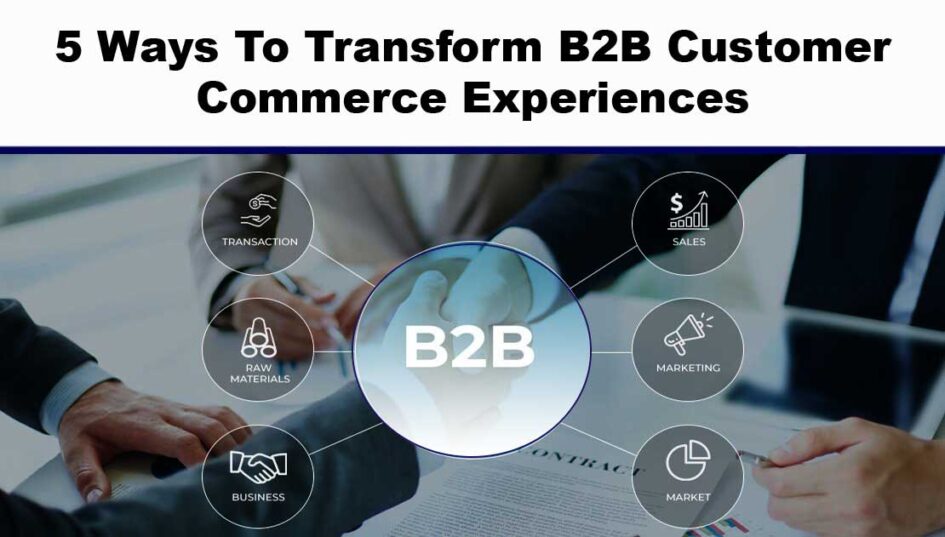Today in our digital transformation era, no doubt that customer retention and customer loyalty, and lasting relationships are crucial to growing and scaling your B2B business. Keeping your client’s needs at the center of your eCommerce re-platforming; making changes that will improve their experiences, and providing long-term benefits. All will be key to keeping customers happy, satisfied, and loyal. There are ways to transform your B2B customers’ experiences.
In our previous blogs, we discussed the true challenges that a B2B business experiences with its digital commerce transforming process. Also defining goals before starting any new commerce initiative. In this blog, we’ll dive into more detail. What are the priorities that must be identified by your team that will focus on customer experience? What are the resources and investments required to get it right?
B2B Customer Experience and the Role of Commerce Platforms
To simplify matters, you can ask yourself these simple questions. How can you make it easier for customers to do business with you? Whether regarding their purchasing process, their day-to-day interactions, and communication with you. Do you have the right digital commerce platform in place that can allow you to deliver excellent customer experiences? Can your current platform alleviate the strain on internal teams and operations?
We have summarized below the five ways where both your B2B customers and your team can leverage the benefit of implementing experienced-focused capabilities by choosing the right eCommerce platform.
- Shopping Experience
- Purchasing Experience
- Post-Purchase Experience
- Follow Up and Support
- Loyalty & Reordering
1. B2B Customers Experiences: Product Catalog & Search
Organizing and building a clear, detailed product catalog easy to use, search, filter, and complete quality product information is something that should never be neglected.
Product organization and search are important for two reasons. First, your team can have a big impact here. Let’s admit, most businesses fail to fully utilize the internal knowledge from their sales team, account reps, and others to convert their customer knowledge onto the storefront. What terms do customers use when describing or referencing your product catalog? Are they starting their shopping at the category or individual item level? Starting with that knowledge and leveraging the capabilities in the commerce platform to create search criteria, product data attributes, and a product category map that meet their expectations.
Before investing in the latest generation of AI or expensive integrated search services, simple improvements to product data organization can dramatically improve the shopping experience and conversion rates. Don’t forget, before you can build out a complex faceted search – you will need to have the product data breadth to support it.
2. B2B Purchasing Experience
Consistency wins! Once you decided to move your customers into the digital buying world. They want to be able to shop for the same products, ship to the same addresses, and pay the same way. This can be a unique challenge. Typically, large bulk orders and credit card purchases can be problematic. Thus, buying on credit against an account limit can be very attractive to any online shopper who wants to make the same purchase online or offline.
In addition to the payment method and adding credit/account buying at checkout, making more information about the account available to the customer in real-time enables more buying behavior. A complete self-service portal doesn’t have to involve taking actions (although it should), there is significant value in displaying the existing account balance, credit limit and any company discounts being applied. Delivering visibility to the customer to ensure they know of their account status before ordering shows a level of transparency that they would expect.

3. Post-Purchase B2B Customers’ Experience
Let’s be honest – we’re all spoiled. Whether ordering toys or snacks, we want to know exactly when our order is shipped, where it is now, and when it will be delivered to your door. Up until recently mostly, B2B sellers have been able to avoid that real-time status.
The post-purchase experience comes down to accurately delivering three key pieces of information in order to meet the most basic of expectations.
Firstly, when is my order going to ship?
For businesses ordering supplies required for their own business operation or completing a finished good. Delivery expectations can throw their entire production and/or customer delivery out of sync – costing them significantly.
Secondly, did my order ship?
Yes, it’s that easy. “Your order, either fully or partially, has gone out the door.” Here’s what has been shipped to you. Before the customer worries, places a new order with a competing vendor, or places angry phone calls…let them know.
Finally, where is my order?
Tracking. One email with the tracking number for the partial or complete order status.
Applying those pieces of information and communicating via the customer portal on your storefront alongside email automation/workflow in post-purchase emails will put any company ahead of the majority of its competition in the B2B space.
4. Follow-Up Experience
Leveraging a successful customer experience to drive more business and learning. Investing a small amount of time to build an automated workflow using the commerce engine to deliver messaging to the customer for feedback.
The messaging can appear to come from an account representative asking for more of a freeform follow-up. Or use a more templated approach to ask for product reviews directly on the website.
Other sales teams have utilized a workflow system to create follow-up tasks for themselves, especially if the customer made a large equipment purchase, to follow up and make sure they’ve received the support, training, and materials they need for proper installation.
Building more communication into a post-order workflow and follow-up experience means doing more than asking for a review in a very in-personal way.
5. Reordering Experience
When you’ve locked down the follow-up experience – checking in with customers who have recently ordered, gathering feedback, and collecting reviews, then it’s time to focus on earning that second order.
If your business sells supplies or add-ons to a large initial purchase, building out specific shopping pages with a collection of those relevant items is going to be helpful. However, reordering may be as simple as adding a “reorder” button to the “My Account” or customer portal. One-click to quickly duplicate an existing order and move the customer directly to the cart.
The “reorder” option eliminates any frustration around searching for and configuring the same previous orders. Consider that a one-click reorder process can also be configured to allow the customer to select reorder and then mark the items they would like to purchase again or adjust quantities either at the cart or
To summarize
Launching an effective and highly converting B2B site starts with focusing on your B2B customers’ experiences. Starting with asking yourself “Where are we frustrating our customers?” and leveraging technology to create solutions. Finally, to be most effective, you can’t rely on technology alone to generate positive outcomes and solutions. But leverage the knowledge inside your organization from historical customer interactions and product and industry knowledge for the ideal solutions.


